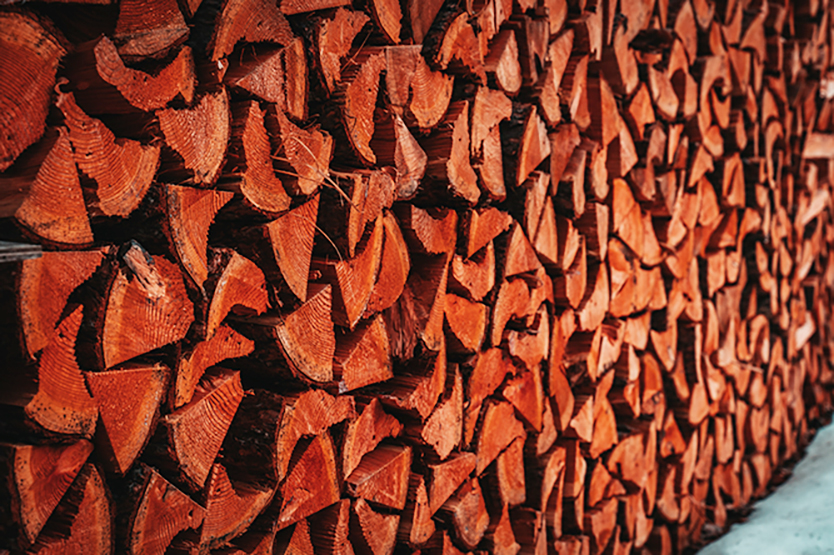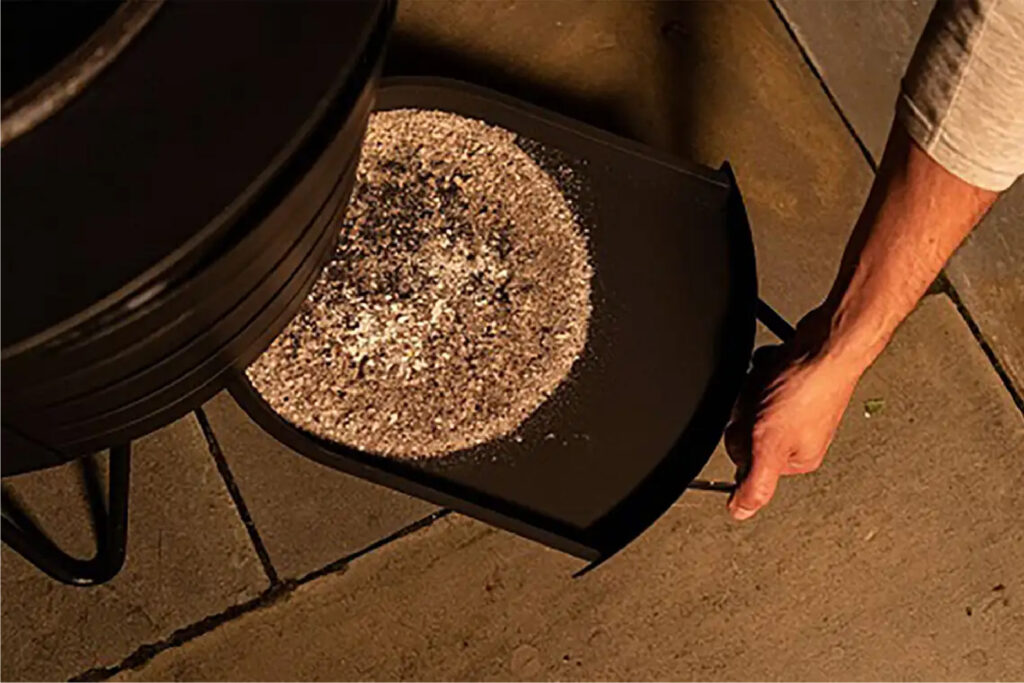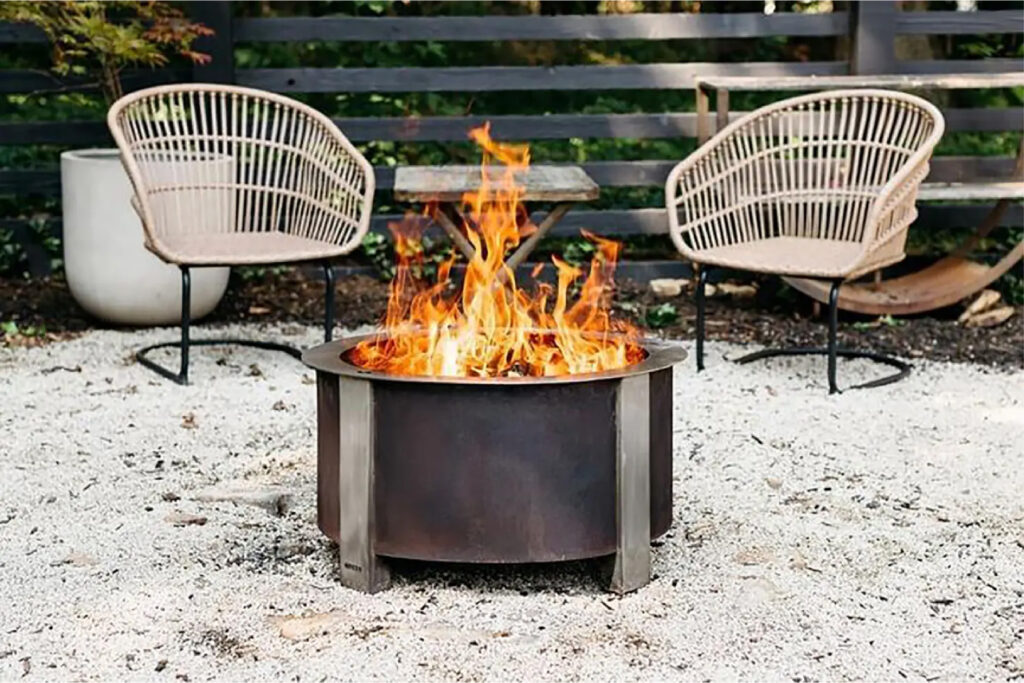Imagine cozying up with friends and family around a crackling fire pit, enjoying the warmth and ambiance it provides. But what if you could have all of that without the smoke and hassle? In this article, we will explore the world of smokeless wood-burning fire pits and guide you toward choosing the best one for your needs.
Important Pros of Wood-Burning Smokeless Firepit
| 1. Smoke reduction: Smokeless fire pits significantly reduce or eliminate smoke production, allowing for a more enjoyable and comfortable outdoor experience. |
| 2. Improved air quality: With reduced smoke, there is less harmful particulate matter released into the air, resulting in better air quality for you and your surroundings. |
| 3. Minimal environmental impact: Smokeless fire pits promote cleaner burning, minimizing the environmental impact typically associated with traditional wood-burning fires. |
| 4. Efficient and effective: These fire pits are designed to maximize the combustion process, resulting in efficient burning and optimal heat output. |
| 5. Enhanced safety: Smokeless fire pits often come with safety features such as spark arrestors and heat shields, reducing the risk of accidents and providing peace of mind. |
| 6. Versatility: Many smokeless fire pits are portable and can be easily moved, allowing you to enjoy a smoke-free fire experience wherever you go. |
| 7. Aesthetically pleasing: Smokeless fire pits often feature sleek and modern designs, adding an attractive element to your outdoor space. |
| 8. Social and cozy ambiance: Despite being smokeless, these fire pits still provide the warmth and ambiance of a traditional wood-burning fire, making them ideal for gatherings and relaxation. |
How Smokeless Wood-Burning Fire Pits Work
Smokeless wood-burning fire pits utilize a combination of design and technology to minimize smoke production. These fire pits often incorporate secondary burn chambers or advanced airflow systems that facilitate complete combustion. By introducing preheated air into the fire chamber, the volatile components in the wood are burned, reducing the creation of smoke.
The clever design of smokeless fire pits also allows for efficient fuel usage. With controlled airflow, the wood burns evenly, leaving behind minimal ash and maximizing the heat output. Some fire pits even include features like adjustable airflow vents, giving you control over the fire and allowing you to fine-tune the burn rate according to your preferences.
Factors to Consider When Choosing a Smokeless Wood Burning Fire Pit
When selecting the best smokeless wood-burning fire pit for your outdoor space, several factors should be taken into account. Firstly, consider the size and capacity of the fire pit. Determine whether you need a compact and portable option or a larger fire pit for hosting larger gatherings.
Next, pay attention to the materials used in the construction of the fire pit. Opt for durable and heat-resistant materials like stainless steel or cast iron that can withstand the high temperatures produced by the fire. Additionally, look for fire pits that offer easy assembly and disassembly, making them convenient to transport or store during the off-season.
Another crucial consideration is the aesthetics of the fire pit. Choose a design that complements your outdoor space and matches your personal style. Finally, assess the safety features provided by the fire pit, such as spark screens or heat-resistant handles, to ensure a secure and worry-free experience.
Top 5 Smokeless Wood-Burning Fire Pits on the Market
| Rank | Fire Pit Model | Brand | Price | Features |
|---|---|---|---|---|
| 1 | Solo Stove Bonfire | Solo Stove | $299.99 | Smokeless, stainless steel construction |
| 2 | Breeo X Series | Breeo | $449.00 | Smokeless technology, stainless steel |
| 3 | BioLite FirePit+ | BioLite | $249.95 | Smokeless, portable, rechargeable |
| 4 | TIKI Brand Fire Pit | TIKI Brand | $299.99 | Smokeless, adjustable flame |
| 5 | Blue Sky Outdoor Pit | Blue Sky Outdoor | $199.99 | Smokeless, stainless steel construction |
Wood Burning Smokeless Firepit Bad for the Environment
| Potential Negative Environmental Aspects of Wood Smokeless Fire Pits |
|---|
| 1. Carbon emissions: While smokeless fire pits are designed to burn wood more efficiently, they still produce carbon dioxide (CO2) emissions. Although these emissions may be lower than traditional fires, they still contribute to greenhouse gas emissions and climate change. |
| 2. Wood sourcing: Wood is the primary fuel for smokeless fire pits, and it is essential to consider the sustainability and responsible sourcing of the wood. The use of non-renewable or illegally harvested wood can contribute to deforestation and habitat loss. Opting for sustainably sourced firewood or using alternative fuels like pellets can mitigate this issue. |
| 3. Air pollution: While smokeless fire pits reduce smoke production, there may still be some emissions of particulate matter and other pollutants. Although the emissions are minimized, they can still contribute to local air pollution, affecting air quality in the immediate vicinity. |
| 4. Energy consumption: Some smokeless fire pits may require an external power source, such as a battery or electricity, to operate additional features like fans or air circulation systems. Depending on the energy source, this can contribute to overall energy consumption and potentially rely on non-renewable resources. |
| 5. Waste generation: Regular maintenance and cleaning of smokeless fire pits may result in the generation of ash and waste wood. Proper disposal of these byproducts is necessary to prevent environmental contamination. Consider recycling or composting options for wood waste if available. |

Comparison of Smokeless Wood-Burning Fire Pits
| Fire Pit | Material | Airflow System | Price | Customer Rating |
|---|---|---|---|---|
| The Inferno | Stainless Steel | Advanced airflow system | $299 | 4.8/5 |
| The EmberGlow | Cast Iron | Secondary burn chamber, adjustable vents | $399 | 4.7/5 |
| The Everlasting Flame | Steel | Efficient combustion | $249 | 4.6/5 |
| The Serene Hearth | Copper | Decorative design | $349 | 4.5/5 |
| The Wilderness Blaze | Lightweight materials | – | $199 | 4.4/5 |
Maintenance and Care Tips for Smokeless Wood Burning Fire Pits
| 1. Regular cleaning: Clean out the fire pit after each use to remove ash, debris, and any leftover wood. Use a brush or a designated ash tool for this task. |
| 2. Check for damage: Inspect the fire pit regularly for any signs of damage, such as cracks or rust. Address any issues promptly to ensure safe operation. |
| 3. Clean the air vents: Clear any obstructions from the air vents to maintain proper airflow, which is crucial for smokeless combustion. Remove any debris or ash buildup that may restrict airflow. |
| 4. Protect from the elements: If your fire pit is not designed for outdoor exposure, consider covering it or storing it in a sheltered area when not in use to prevent damage from rain, snow, or excessive moisture. |
| 5. Use proper fuel: Follow the manufacturer’s guidelines regarding the type and size of wood or fuel to use in your smokeless fire pit. Using the recommended fuel ensures optimal performance and minimizes smoke. |
| 6. Store fuel correctly: If you store wood or fuel near the fire pit, ensure it is kept in a dry and well-ventilated area to prevent moisture buildup or mold growth. |
| 7. Clean the exterior: Keep the exterior of the fire pit clean and free from dirt or residue. Use mild soap and water to wipe down the surface periodically, especially if it has accumulated grime or stains. |
| 8. Follow safety precautions: Always exercise caution and adhere to safety guidelines when operating the fire pit. This includes maintaining a safe distance from flammable objects, never leaving the fire unattended, and using appropriate fire extinguishing equipment nearby. |

Outdoor Safety Precautions When Using a Smokeless Wood-Burning Fire Pit
| Outdoor Safety Precautions When Using a Smokeless Wood Burning Fire Pit |
|---|
| 1. Clear the area: Ensure the area around the fire pit is clear of any flammable objects such as dry leaves, branches, or furniture. Maintain a safe distance from structures, plants, and other combustible materials. |
| 2. Choose a stable location: Set up the fire pit on level and non-flammable surfaces such as concrete, stone, or gravel. Avoid placing it on wooden decks or near flammable surfaces that could be damaged by heat. |
| 3. Create a safe zone: Establish a designated safe zone around the fire pit, especially if children or pets are present. Use markers or barriers to indicate the boundary and prevent accidental contact with the fire. |
| 4. Keep a fire extinguisher nearby: Have a suitable fire extinguisher readily available in case of emergencies. Make sure you know how to use it properly and that it is in good working condition. |
| 8. Be mindful of wind conditions: Pay attention to wind direction and strength when using a fire pit. Position yourself and any seating arrangements in a way that minimizes the risk of embers or sparks being carried toward flammable objects. |
| 6. Use fire-resistant tools: When tending to the fire, use long-handled tools specifically designed for fire pits. This helps keep a safe distance from the flames and reduces the risk of burns or accidents. |
| 7. Extinguish properly: Before leaving the area, fully extinguish the fire by carefully pouring water over the embers and stirring them with a long tool. Ensure the fire is completely out and cool to the touch. |
| 8. Be mindful of wind conditions: Pay attention to wind direction and strength when using a fire pit. Position yourself and any seating arrangements in a way that minimizes the risk of embers or sparks being carried toward flammable objects. |
| 9. Follow local regulations: Familiarize yourself with any local ordinances or regulations regarding open fires or fire pit usage in your area. Ensure you comply with the guidelines to prevent any legal or safety issues. |
Creative Ways to Use a Smokeless Wood-Burning Fire Pit
| Creative Ways to Use a Smokeless Wood Burning Fire Pit |
|---|
| 1. Outdoor cooking: Utilize the fire pit’s heat and flames for cooking delicious meals. Roast marshmallows, cook hot dogs, or even try your hand at grilling vegetables or meats on a grate or skewers. |
| 2. Warmth and ambiance: Gather around the fire pit during chilly evenings to enjoy its warmth and create a cozy atmosphere for socializing, storytelling, or stargazing with family and friends. |
| 3. Outdoor movie nights: Set up a screen or projector nearby and create an outdoor movie theater experience. Snuggle up around the fire pit while watching your favorite films under the stars. |
| 4. Fire pit desserts: Get creative with fire pit desserts like s’mores variations, campfire pies, or even baking cookies in cast-iron pans over the flames. Explore different recipes and indulge in tasty treats. |
| 5. Heat for outdoor activities: Extend the usability of your outdoor space during colder seasons. Use the fire pit’s warmth to make your patio or deck comfortable for activities like reading, yoga, or simply relaxing. |
| 6. Backyard camping: Enhance your backyard camping experience by setting up a tent nearby and enjoying the fire pit as your campfire. Share stories, roast marshmallows, and create lasting memories. |
| 7. Outdoor art and entertainment: Arrange a DIY art station or a small outdoor concert near the fire pit. Create art, play music, or engage in other creative activities while enjoying the soothing flames. |
| 8. Fire pit game nights: Organize game nights around the fire pit. Play board games, card games, or even create your own outdoor game activities to enjoy with family and friends. |
| 9. Meditation and relaxation: Take advantage of the fire pit’s calming presence for meditation or relaxation sessions. Sit nearby, close your eyes, and let the crackling sounds and warm glow help you unwind. |
| 10. Year-round outdoor living: With a smokeless fire pit, you can enjoy your outdoor space throughout the year, extending your living area and creating a cozy and inviting environment for various activities. |

Customer Reviews and Testimonials
Review 1: “I purchased the Inferno smokeless fire pit for our camping trips, and it has been a game-changer. The lack of smoke allows us to enjoy the fire without constantly moving away to avoid discomfort. Highly recommended!” – Sarah D.
Review 2: “The EmberGlow fire pit is a beautiful addition to our backyard. Not only does it look stylish, but the smokeless feature works like a charm. We’ve had cozy evenings with friends, and everyone loves the ambiance it creates.” – Mark S.
Review 3: “After extensive research, I decided on the Everlasting Flame fire pit, and I’m thrilled with my purchase. It burns wood efficiently, and the large fuel capacity means we can enjoy a longer fire without constant refueling. A fantastic investment!” – Emily M.
Frequently Asked Questions
- Q: Are smokeless wood-burning fire pits safe to use in residential areas?
- A: Yes, smokeless wood-burning fire pits are safe to use in residential areas. However, it’s essential to follow safety guidelines and local regulations regarding fire pit usage.
- Q: Can smokeless fire pits be used for cooking?
- A: Yes, many smokeless fire pits come with cooking accessories or grill grates, allowing you to cook various foods over the fire.
- Q: Do smokeless fire pits eliminate all smoke?
- A: While smokeless fire pits significantly reduce smoke production, there may still be minimal smoke during the initial lighting or when adding new wood.
- Q: Are smokeless fire pits suitable for small outdoor spaces?
- A: Yes, smokeless fire pits are available in various sizes, including compact options perfect for small outdoor spaces like patios or balconies.
- Q: Can smokeless fire pits be used for heat during colder months?
- A: Absolutely! Smokeless fire pits provide warmth and can be a cozy heat source during colder months, allowing you to extend your outdoor enjoyment.
Conclusion
Investing in a smokeless wood-burning fire pit allows you to enjoy the warmth and ambiance of a fire without the inconvenience of smoke. These innovative fire pits provide numerous benefits, including reduced smoke production, efficient combustion, and minimal maintenance. By considering factors like size, materials, and design, you can select the best smokeless fire pit to enhance your outdoor experience.
Remember to prioritize safety by following outdoor safety precautions, properly maintaining the fire pit, and adhering to local regulations. Explore creative uses for your smokeless fire pits, such as outdoor cooking, cozy gatherings, stargazing nights, campfire storytelling, and outdoor movie nights.
FAQs
- Are smokeless wood-burning fire pits completely smoke-free?
- Can smokeless wood-burning fire pits be used for cooking?
- Do smokeless wood-burning fire pits require any special type of wood?
- Can smokeless wood-burning fire pits be used in all weather conditions?
- How long do smokeless wood-burning fire pits typically last?

